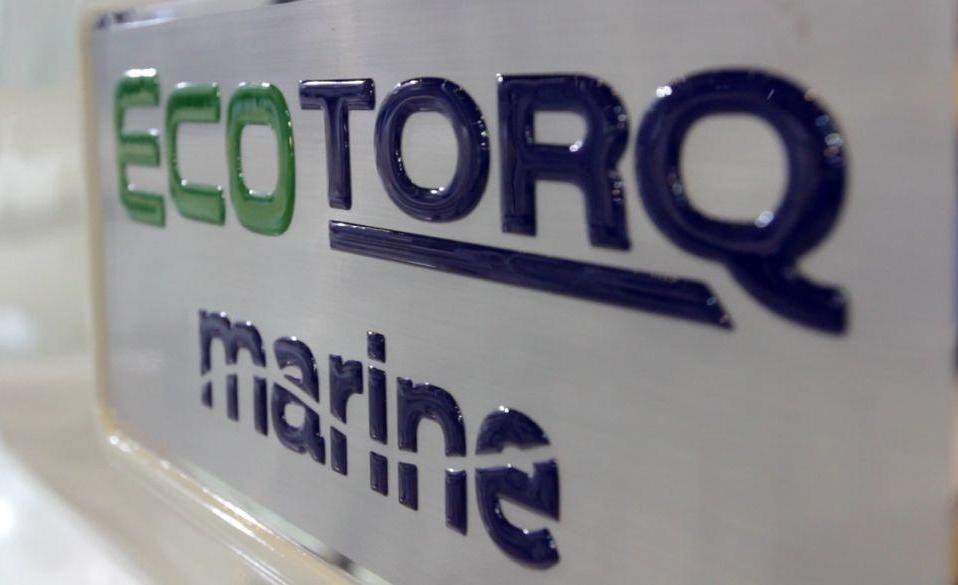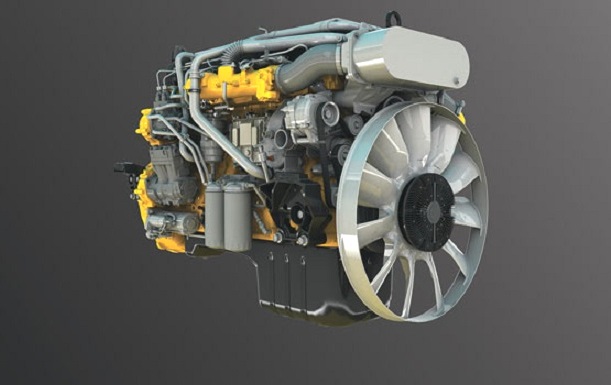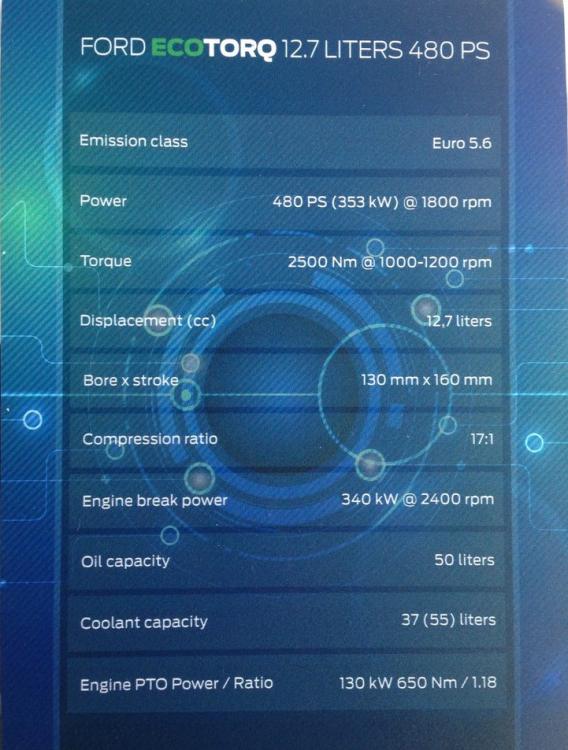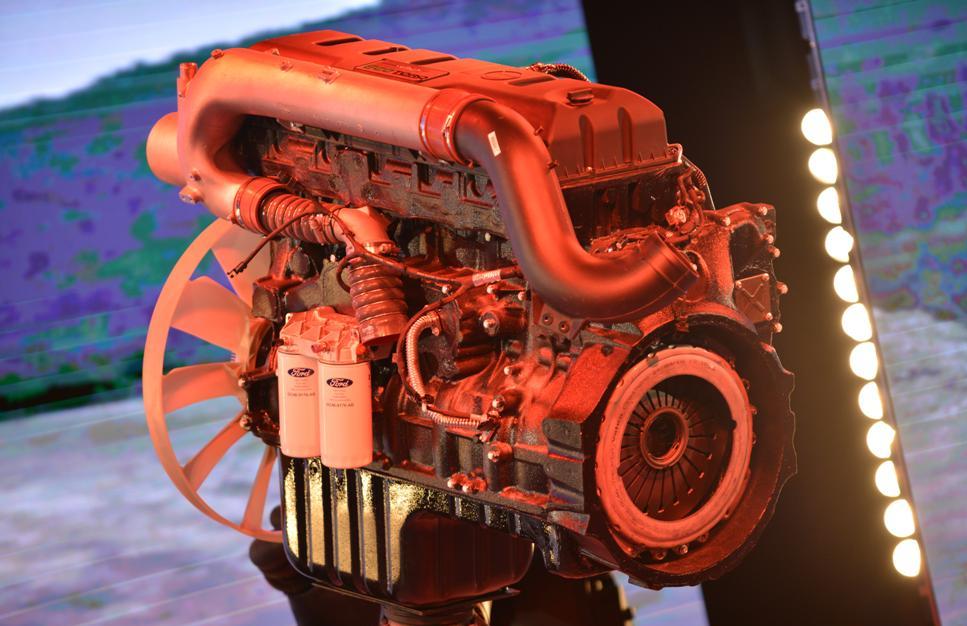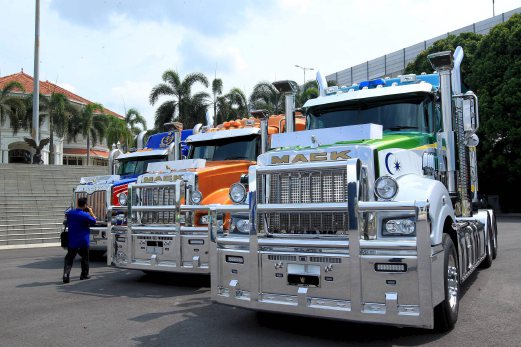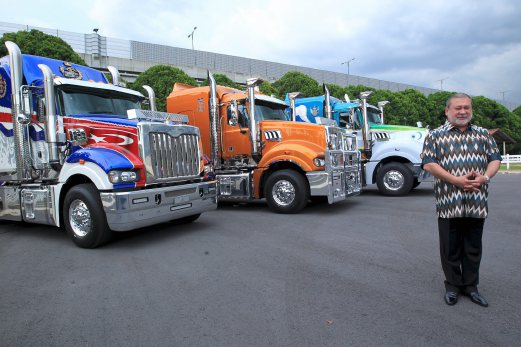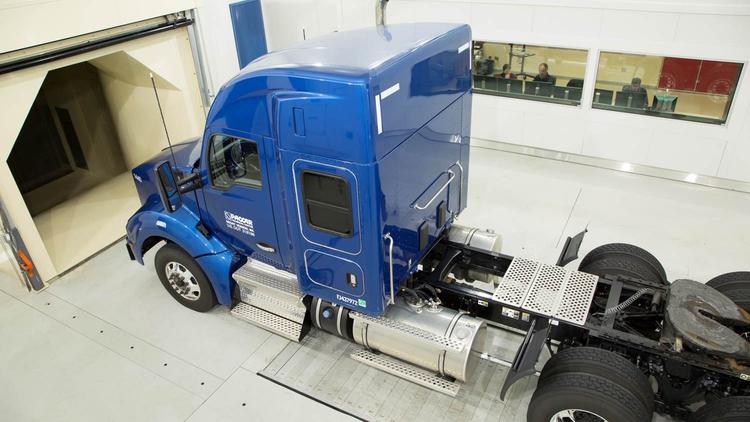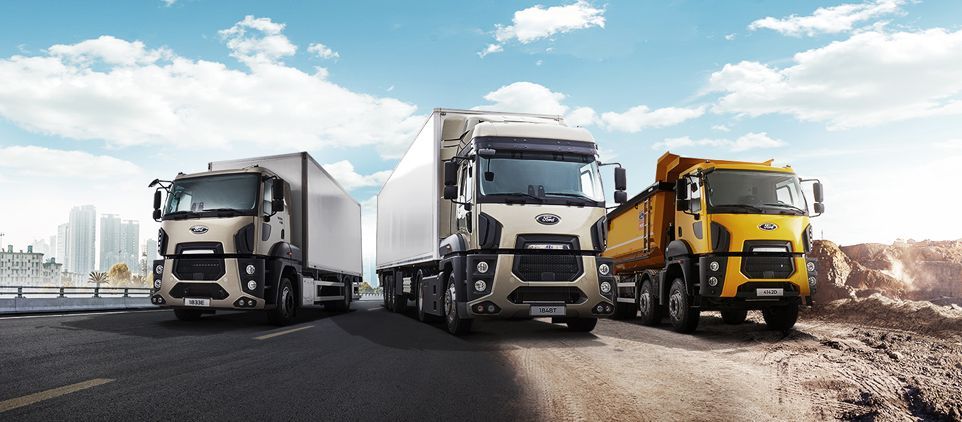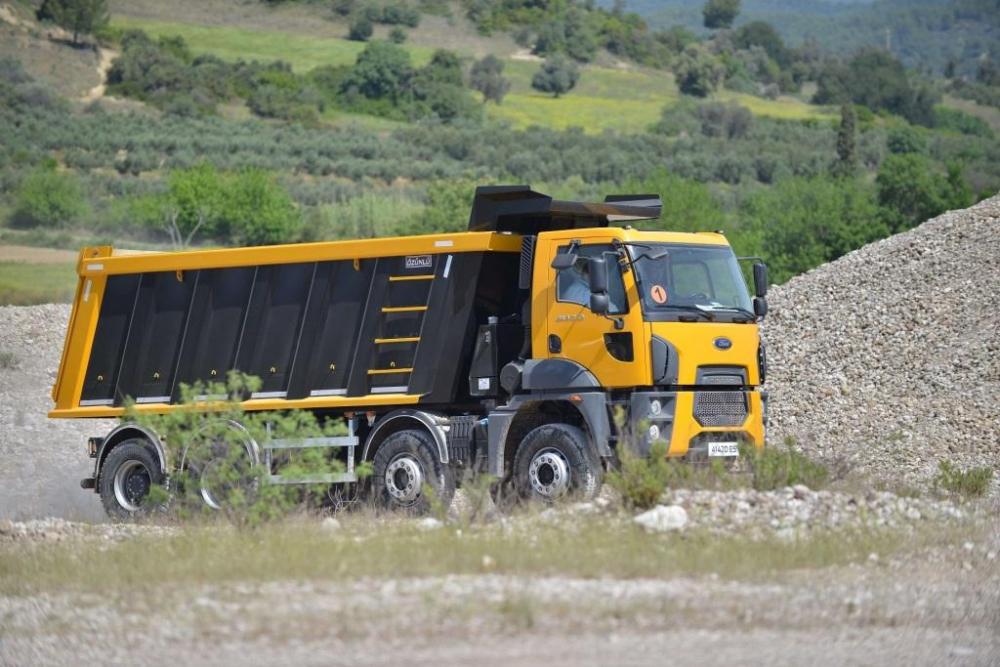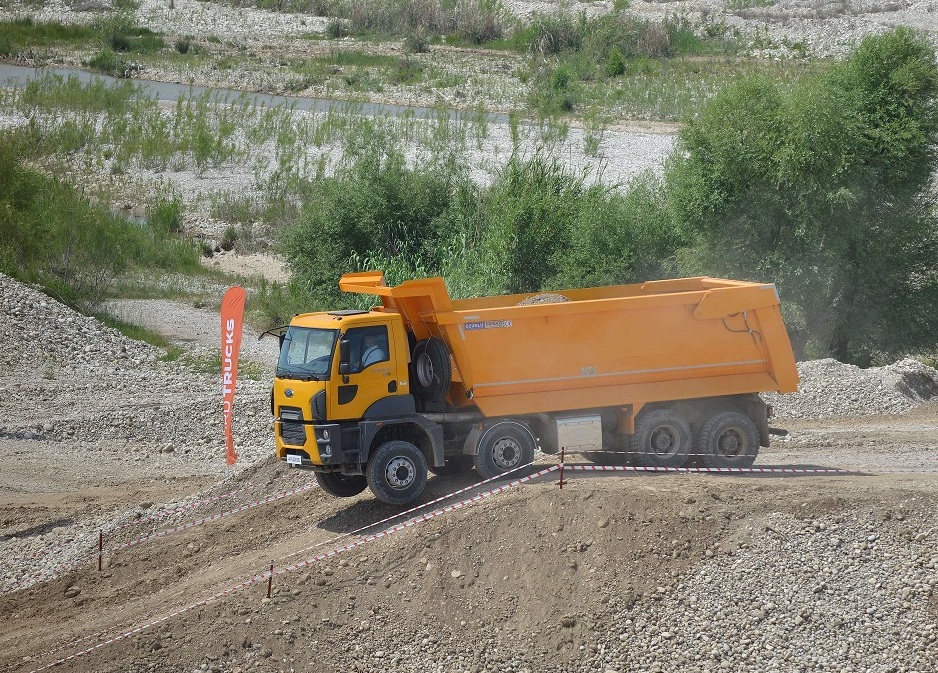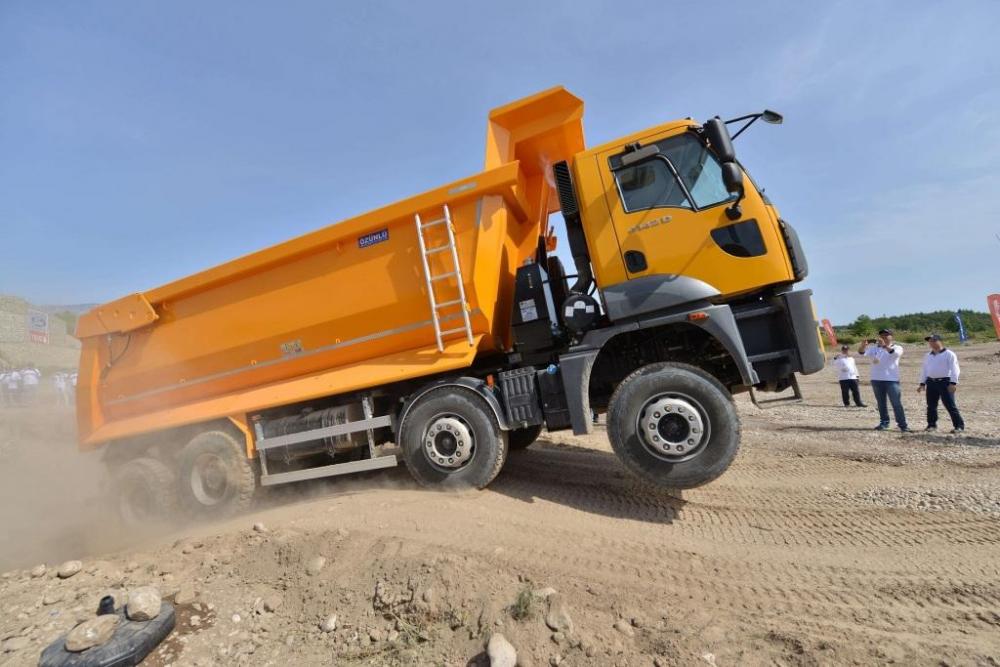
kscarbel2
Moderator-
Posts
18,893 -
Joined
-
Days Won
114
Content Type
Profiles
Forums
Gallery
Events
Blogs
BMT Wiki
Collections
Store
Everything posted by kscarbel2
-
Mack Adds Automated Manual Transmissions for Vocational Use
kscarbel2 replied to kscarbel2's topic in Trucking News
Mack makes mDrive HD 13-speed standard on Granite models Truck News / May 9, 2016 Mack Trucks announced today it that its mDrive HD 13-speed automated manual transmission (AMT) will be standard on Mack Granite models. The AMT features a low ratio creeper gear and helps boost customer productivity thanks to improved performance and reduced weight, Mack says. The mDrive HD 13-speed (aka. Volvo I-Shift with crawler gears) is also available on the Mack Pinnacle and Titan by Mack models. “Making the mDrive HD 13-speed standard on the Granite is a natural evolution of our industry leadership,” said Dennis Slagle, president of Mack Trucks. “Since its introduction, the mDrive has become incredibly popular – starting first with highway and more recently with many heavy-duty vocational applications. The introduction of the 13- and 14-speed gears expands the range and performance in vocational applications so much so that it is only natural for it to become our standard offering in the Granite model.” The AMT is available in both direct or overdrive configurations and offers a low reduction creeper gear ratio designed for easier startability on steep grades or when the truck is carrying a heavy load. This improved startability also allows customers to select a faster rear axle ratio. The faster ratio decreases engine rpm at highway speeds, saving fuel as the truck travels between job sites. It is also monitored by Mack GuardDog Connect. In March, Mack also announced the availability of the mDrive HD 14-speed. “Response to the mDrive and mDrive HD has been tremendous,” said Roy Horton, director of product strategy. “Currently, mDrive penetration for Pinnacle axle back and axle forward models is at approximately 80% and 60%, respectively, while mDrive HD penetration for Granite models is about 20% and growing. The penetration level of mDrive in all our models has continued to increase since its introduction.” The Mack Granite model is available in axle forward or axle back configurations. The Mack mDrive HD 13- and 14-speed AMTs are scheduled to go into full production in October. Volvo Group Press Release - http://www.volvogroup.com/group/global/en-gb/volvo%20group/worldwide/volvo-group-north-america/_layouts/CWP.Internet.VolvoCom/NewsItem.aspx?News.ItemId=151864&News.Language=en-gb -
Germany’s Mann+Hummel completes WIX acquisition
kscarbel2 replied to kscarbel2's topic in Trucking News
Yet another example of American companies being acquired by overseas aggressors. Once upon a time, America led the world in innovation and industrial might. But as a result of government casting a blind eye to the fast declining state of American industry, a significant portion of U.S. industry is now under foreign ownership. In order for a major country like the United States to regain its position as a world leader, we must have a solid economy, which inherently requires a solid industrial foundation. Today, we no longer have that. Much has been allowed to go abroad, while the meager remnants remaining is being sold to foreign companies. - Germany’s Mann + Hummel bought Affinia Group, producer of Wix, Napa and other brand filters - Germany's ZF has acquired TRW - Italy's Fiat owns Chrysler, Dodge and Jeep - China's Wanxiang has acquired over 20 U.S. businesses including U.S. government-funded battery maker A123, Dana’s coupled-products business, Neapco and D&R Technology. - Germany's Daimler acquired Freightliner, Western Star, Detroit Diesel and Thomas Built Buses - Sweden's Volvo acquired White, Autocar, GMC heavy truck and Mack Trucks - Germany’s Knorr-Bremse owns Bendix Commercial Vehicle Systems - Sweden’s Haldex acquired Anchorlok and the Neway suspension control valve business - Germany’s SAF acquired Neway air suspensions, and 5th wheel makers Holland and Simplex - Prestolite Electric, which includes the Leece-Neville brand, was acquired by Zhongshan, China-based Broad Ocean Motor Company and Beijing-based Ophoenix Capital. - Nexteer Automotive aka GM Global Steering Holdings LLC (formerly Delphi Steering and GM’s Saginaw Steering Division) was acquired by Chinese government-owned Pacific Century Motors - Germany’s Mahle acquired Delphi’s automotive air conditioning division, Delphi Thermal - Korea's Doosan owns Bobcat - Aircraft and industrial engine maker Teledyne Continental Motors was acquired by Chinese government aircraft maker AVIC - Canada's Bombardier acquired Learjet Corporation - Mexico's KUO Group acquired Borg-Warner and Spicer transmissions - Italy's Fiat thru subsidiary CNH Global owns Case-IH and New Holland - Sweden's Volvo acquired the road construction equipment division of Ingersoll Rand - Japan's Bridgestone owns Firestone and Bandag - France's Michelin owns Uniroyal and BF Goodrich - China’s Beijing West Industries acquired Delphi’s brake and suspension divisions - Netherlands-based Mittal Steel acquired (asset holder of Bethlehem Steel, LTV, Weirton Steel, Georgetown Steel and US Steel) - Mexico's Metalsa S.A. acquired 10 Dana plants that produce structural components for chassis and body structures in light and commercial vehicles - Germany's Siemens acquired Houston-based Dresser-Rand - China's Shuanghui owns Smithfield Foods - Belgium's InBev owns Anheuser-Busch - South African Breweries (SAB) acquired Miller Brewing - Germany's Merck KGaA acquired St. Louis-based Sigma-Aldrich - Switzerland's Nestle owns Gerber baby foods and Purina - Sweden's Electrolux owns the Frigidaire, Kenmore and Tappan appliance brands - South Korea's LG owns Zenith - Netherlands-based Philips acquired Magnavox, Philco and Sylvania - China's Lenovo acquired IBM's personal computing division - Japan's Seven & I Holdings owns 7-Eleven - The UK's InterContinental Hotels Groups owns the Holiday Inn and Crowne Plaza hotel chains, and Candlewood Suites - China's Wanda Group owns the AMC cinema chain - The Venezuelan government owns Citgo - Mexico's Bimbo Group acquired Sara Lee's bakery business and the following brands: Arnold, Ball Park, Boboli, Brownberry, Cinnabon Bread, EarthGrains, Entenmann’s, Francisco, Freihofer’s, Marinela, Milton’s Bread, Mrs Bairds, Oroweat, Roman Meal, Sara Lee, Stroehmann, Sun-Maid Bread, Thomas’ and Tia Rosa. - The British-Dutch conglomerate Unilever owns Ben & Jerrys, Vaseline, Hellmann’s, Best Foods, Ponds, Good Humor and Breyers - Germany's Henkel owns Dial soap, Loctite, Orbseal and Bergquist - Germany's Bayer acquired Miles Laboratories and Cutter Laboratories (including Cutter insect repellent, Alka-Seltzer, One-A-Day, Flintstones vitamins and Bactine), and the consumer care business of Merck & Co. which included the brands Claritin (allergy), Coppertone (sun care), MiraLAX (gastrointestinals), Afrin (cold) and Dr. Scholl’s. - Bayer CropScience acquired biological company AgraQuest - Thailand’s Thai Union Frozen Products owns Chicken of the Sea and Orion Seafood International - South Korea’s Dongwon owns StarKist - The UK’s Lion Capital owns Bumble Bee Foods - Jim Beam was acquired by Japan’s Suntory in 2014 - Krispy Kreme has been acquired by Luxembourg-based JAB Holdings - Giant Carlisle (Martin's Food Markets, Ukrops), Stop & Shop and Giant-Landover supermarkets are owned by Dutch retailer Koninklijke Ahold N.V. - Food Lion and Hannaford supermarkets are owned by Belgium-based Delhaize Group - Colombia's Cementos Argos has acquired the cement and ready mix producing assets of Vulcan Materials and LaFarge - UK-based Tarmac PLC acquired the cement and ready mix producing assets of Stamford, Conn.-based Lone Star Industries (for many years the largest U.S. cement maker) - Two-wheeled electric people mover Segway has been acquired by China’s Ninebot - China’s HNA Group acquired Carlson Hotels Inc. (Radisson, Park Plaza, Country Inns) The list becomes longer with each passing year. -
Fleet Owner / May 9, 2016 The parent company of WIX Filters and Filtron has been acquired by Mann+Hummel. Mann+Hummel will lead Affinia Group as a new business unit based in North Carolina. Keith Wilson, previously CEO and president of Affinia, will retain his executive function as president and CEO of Mann+Hummel Filtration Technology and report to Manfred Wolf, the supervisory board chairman of the acquired company, the firm said. “The addition of the Wix and Filtron brands to Mann+Hummel strengthen our global presence with an expanded product portfolio and access to new markets,” said Alfred Weber, president and CEO. “Our joint 150 years of experience, complementary competencies, and 20,000 valued employees worldwide ensure that we will continue to grow and serve our customers with the best in filtration solutions.” Affinia's filtration business specializes in the oil, fuel, hydraulic and coolant filter aftermarket. Mann+Hummel is a privately-held global filtration company offering filtration solutions to original equipment and aftermarket customers in both the automotive and industrial sectors.
-
-
-
Yatvitrini / February 26, 2016 The Ford-Otosan unit of Ford Motor Company has introduced an all-new diesel marine engine range at the 9th annual Eurasia Boat Show exhibition. The line-up includes both Ford’s 9-liter engine, and 12.7-liter “Ecotorq” powerplant rated up to 700 horsepower. Marine versions of the engines have been tested over 80,000 hours, and been designed to offer record low NVH levels (noise, vibration and harshness) with emissions levels up to Euro-6. .
-
-
The European test cycle for Euro-6 is easier than EPA2010, but essentially, the U.S. and global (Euro) emissions standards have virtually merged at this point, making it possible to offer both emissions variants, as Paccar, Daimler and Volvo do.
-
They easily could be sold in the US market, but currently Ford only plans to pursue the global market.
-
The New Straights Times / May 8, 2016 The annual Kembara Mahkota Johor (KMJ) royal tour in Malaysia will again hit the road this Saturday. Celebrating its 19th anniversary, the royal tour would involve a journey to 10 districts over four days and would cover a total distance of 842 km. The highlight of the trip is the truck that Sultan Ibrahim Sultan Iskandar will be driving, a RM1.4 million (US$350,000) custom-built red, blue and white Mack truck from Australia, which was received by Sultan Ibrahim in January. Instead of one truck, the KMJ will also see the debut of two more customized Mack trucks, one embellished in an orange colored theme while the other with a scorpion theme design. The other two Mack trucks will be driven by Tunku Mahkota Johor Tunku Ismail Sultan Ibrahim and Tunku Panglima Johor Tunku Abdul Rahman Sultan Ibrahim. Besides the trucks, other vehicles in the entourage includes 35 Harley Davidson motorcycles, ten 4WD vehicles ferrying officials and escorted by Royal Malaysian Police along all the stops. State secretary Datuk Ismail Karim said the annual royal tour this year has no special theme but the objectives remain the same which is to strengthen the bond between the royal institution and the Johor people in the spirit of 'Bangsa Johor, Raja dan rakyat berpisah tiada'. "This year, the addition of the Mack trucks will make this KMJ the biggest ever held for the past 17 years," he said at the KMJ 2016 pre launch ceremony at Istana Pasir Pelangi yesterday. .
-
Shell Rimula Ultra 5W-30 claims fuel and engine advantages
kscarbel2 posted a topic in Trucking News
Transport Engineer / May 9, 2016 Shell is claiming up to 2% fuel savings and 56% better engine wear protection, as well as longer oil drain intervals, with Shell Rimula Ultra 5W-30 – the oil giant’s most advanced heavy-duty diesel engine oil ever. Shell Rimula Ultra 5W-30 heavy-duty diesel engine oil has been launched with a wide range of truck OEM approvals for Euro 4 to Euro 6 heavy vehicles, and complies with both the latest European specifications (ACEA E6 and E9). Shell recommends its new lubricant for advanced Euro 5 and Euro 6 truck and bus engines, stating that it contributes to warranty compliance for latest technology vehicles and means that mixed fleet operators can reduce the ranges of grades they need. The firm explains that its new oil is based on Dynamic Protection Plus technology, which combines Shell’s PurePlus lubricant production process with its Adaptive Additive technology. The former is based on Shell’s gas-to-liquids process, which converts natural gas into ultra-pure base oil with virtually none of the impurities generally found in crude oil, and delivers optimised viscosity, friction and stability properties. The latter is designed to prevent build-up of acids and deposits on key engine components, including the sump, cylinder head gasket, cylinder sleeve and valve train. Andrew Gibson, Shell’s UK marketing manager, points to trials with OEMs including Mercedes-Benz that have demonstrated its up to 56% wear protection enhancement. He also says that, depending on approvals and manufacturers’ recommendations, oil-drain intervals can be extended to up to 150,000 km – and that operators can expect up to 2% better fuel economy (against typical 10W-40 prodcuts). “Shell Rimula Ultra 5W-30 has been formulated to help customers save time and money, whether they are maintaining a single vehicle or an entire fleet,” states Gibson. In other news, Shell has also further developed its Shell Rimula R6 LM 10W-40 and Shell Rimula R6 M 10W-40 engine oils for utility vehicles have been to comply with a wider range of specifications. -
Puget Sound Business Journal / May 4, 2016 Despite current low global fuel prices Paccar Inc. is pouring research dollars into developing more efficient trucks for the future. Speaking from Paccar’s Bellevue headquarters, CEO Ron Armstrong said the truck builder is sometimes operating its new $50 million truck test facility around the clock, as it works to improve designs. Paccar a year ago opened the “climatic chassis dynanometer” near Mount Vernon, a small city north of Seattle. The facility is part wind tunnel, simulating driving at up to 75 miles an hour, but it also can subject test trucks to changes in temperature, air pressure and humidity. “You can do summer testing, winter testing, mountain testing, valley testing, all in this facility,” Armstrong said. “It really accelerates the development process.” Paccar is the second-largest truck builder in North America, assembling Kenworth and Peterbilt trucks in North America and Australia, as well as DAF trucks in Europe and Brazil. The company generated $4.3 billion in revenue in the first quarter of 2016, and generated $2 billion in profit on $18.7 billion in sales, during 2015. Paccar has achieved 77 consecutive years of profit by taking the long view, and the test facility is an example of that, Armstrong said. “I think fuel prices are bound to go up from this point,” he said. “Fuel efficiency gains are going to continue to be an area of competition to move the needle forward.” The rationale behind the test facility is to extract data on the interaction among all aspects of truck design, including aerodynamics, rolling resistance, advanced digital systems, and Paccar-built engines, Armstrong said. “All elements of aerodynamic capability and fuel efficiency are a key focus. A lot of investment will go into that over the 10-year period,” he said. “It’s very dynamic.” About 300 people work at the Mount Vernon test center, and the new dynanometer is lifting the testing to a higher level, Armstrong said. “There are very few of those in the world. It’s a really unique asset for us, and one that’s been fully utilized since we commissioned it a year ago,” he said of the facility. “This is a very important tool.” .
-
Ford Motor Company – Ford Otosan / May 3, 2016 The culmination of a four year program involving over 750 truck engineers, Ford is proud to announce the 2016 Ford Trucks product range equipped with our new Euro-3, Euro-5 and Euro-6 emissions “Ecotorq” engines. Impressive in design and now available with Euro-6 (near EPA2010) powertrains, Ford’s Cargo heavy truck range raises the bar with a long list of new features including in-cab Wi-Fi, Lane Departure Warning System and Active Emergency Braking System. Ford Trucks and You – "Sharing Each Load Together" "These new trucks are also an important part of Ford Otosan's growth strategy in the coming years. Ford Trucks is once again becoming a global player with a sustainable perspective in the heavy commercial vehicle market”, says Ford Trucks Vice President Ahmet Kınay. “Today, we offer competitive world class products and services, as well as a sales and service network second to none. Ford Trucks is strengthening its brand values to achieve success in the global market. With both financial and technical support from parent Ford, Ford-Otosan has ramped up its R&D and production capabilities. At Ford Otosan, we take the expectations of our global customers seriously, and have created our new brand promise to reflect that. Our new slogan, “Sharing Each Load Together”, signifies our commitment to all our customers around the world. Strong, technically advanced and highly productive Powered by our new Ecotorq engines up to 13 liters in displacement and 480 horsepower, the new generation of Ford Cargo heavy trucks delivers new levels of driving performance and efficiency. Utilizing the latest engine technologies, an increase in fuel efficiency by up to 8.5 percent may be achieved. The multiple advantages of Ford heavy trucks In addition to a new Ford rear air suspension system for vocational models, Cargo heavy trucks are now available with a combined auxiliary braking ability of 1,000 kW (1,341 horsepower) when ordered with the 600 kW (805 horsepower) hydraulic retarder option, and a vocational AMT transmission equipped with off-road, rocking and economy modes. .
-
I have to say that the current (2015) Mack highway truck brochure is the worst to ever represent the brand. Clearly, Volvo hired an advertising company (VSA Partners) which is completely clueless about the truck industry. The painfully bland theme of the brochure, beginning with a cover photo that lacks a truck, prevents customers from even picking up a copy. I will say though, that the unevenness of the highway in the photo reflects the current state of Mack brand management. http://www.macktrucks.com/~/media/files/brochures/mack_highway_brochure.ashx?as=1 Looking at that truckless empty highway on the cover, one is reminded of the lifeless "Born Ready" video in which trucks are shown less than half the time (https://www.youtube.com/watch?v=xAgDmL2oYRA When trucks are visible...........they are always in the background. The video appears to have been originally created for a work clothes manufacturer, and resuscitated in a bid at Volvo's Mack brand business. VSA Partners claims to be a next-generation brand and marketing firm that "designs and activates brands to perform in the modern world" (http://www.vsapartners.com/about/). In order to perform in truck sales marketing, one needs to know something about trucks. And VSA doesn't. But Volvo is obviously to blame for yet another flop in its brand re-identification strategy for the American truck industry's most well known name in trucks. On another note, Volvo has erased spec sheets from the Mack brand website (http://www.macktrucks.com/trucks/pinnacle-series/pinnacle-day-cab/). All one can do is download the "highway brochure", which negates listing all but the most basic specification information. There's no substitute for a spec sheet.
-
Though we're seeing that China is reining in overloading, most Chinese tractor-trailers still run at 45 to 60 metric tons. Thus, operating in the US market at a mere 36.3 metric tons (80,000 lb), these trucks would be on permanent holiday. With high quality and technology nowadays from the leading truckmakers, the market's leading trucks are comfortable, durable and high-performing. The T7's floor is raised, ever so slightly, in the middle. I have no problem with that. I call it virtually flat (like a Scania). I'm not obsessed with the literally flat floor cab. They could easily raise the cab and completely flatten the floor, but with entry and exit in mind, I think the cab's height is perfect as is.
-
California Awards $23.6 Million for Electric Drayage Trucks
kscarbel2 replied to kscarbel2's topic in Trucking News
Buffett-invested BYD is a leader in electric municipal bus design. Tesla could do better, but Musk is not in that market. What's troubling is to remember how GM, Ford and other U.S. companies used to lead the world in technology, particularly during the 1960s. The rest of the world was soooo far behind the U.S., they couldn't even see our dust. And fast forward to today, not a single US company, including Proterra, can create/produce a cutting edge electric bus. This is alike the US truck market which is dominated by foreign truckmakers. That we no longer have the ability to lead/dominate our own truck market, that foreign truckmakers are more skilled/successful in the US truck market than American brands, is damning. -
Transport Engineer / May 4, 2016 ZF has now produced one million of its celebrated commercial vehicle retarders [intarder in ZF speak], originally launched in 1992 to reduce wear on service brakes and ensure safe, fade-free braking. The system, which integrates with the transmission, was designed to take on up to 90% of all braking duty, without involving the service brake, by making 4,000Nm of braking torque available within one second of activation. ZF also estimates that its million intarders have to date prevented the emission of around 60,000 tons of brake dust. “The ZF intarder fulfils several requirements simultaneously: it increases comfort and safety, lowers maintenance costs and improves environmental compatibility,” says Winfried Gründler, head of the truck & van driveline technology business unit in ZF’s Commercial Vehicle Technology division. The system was originally designed to rapidly decelerate a 38-tonne vehicle by delivering 816bhp of retardation downhill, with cruise control automatically taking over downhill drive and intarder activation “Thanks to high demand, ZF has been able to almost double production capacity in the last eight years,” continues Gründler. “After the start of volume production, it took 16 years to reach half a million Intarders in 2008. Just eight years later, we have been able to make the jump to one million.”
-
Commercial Motor TV - sponsored by DAF Trucks / May 5, 2016
-
Commercial Motor TV / April 28, 2016
-
Commercial Motor TV - sponsored by DAF Trucks / April 27, 2016
-
Cummins Press Release / May 3, 2016 Cummins Inc. today reported results for the first quarter of 2016. First quarter revenues of $4.3 billion decreased 9 percent from the same quarter in 2015. Lower production in the North American heavy-duty truck market and weak global demand for off-highway and power generation equipment contributed to the reduction in sales. Currency negatively impacted revenues by approximately 3 percent compared to last year, primarily due to a stronger US dollar. Revenues in North America decreased 10 percent while international sales declined by 8 percent. Within international markets revenues in Latin America and Asia declined the most. Earnings before interest and taxes (EBIT) in the first quarter were $484 million, or 11.3 percent of sales, down from $562 million or 11.9 percent of sales a year ago. Net income attributable to Cummins in the first quarter was $321 million ($1.87 per diluted share), compared to $387 million($2.14 per diluted share) in the first quarter of 2015. The tax rate in the first quarter of 2016, was 28.4 percent. “Our results for the first quarter reflect solid execution of our cost reduction plans in the face of very challenging market conditions,” said Rich Freeland Chief Operating Officer. “Benefits from restructuring actions, material cost reduction projects and lower warranty costs all helped to mitigate the impact of lower sales.” Other recent highlights: Our QSK95 diesel engine received Tier 4 Final certification from the EPA for the US locomotive market. We announced a joint venture with Olayan to expand access to markets and enhance the service and support provided to customers in the Middle East. Ethisphere Institute named Cummins to its list of the world’s most ethical companies for the 9th straight year. We returned $745 million to shareholders in the form of dividends and share repurchases in the first quarter, consistent with our plans to return 75 percent of Operating Cash Flow to shareholders in 2016. Read the full press release – including first quarter detail for all Cummins business units – by clicking on the link below. Press Release – Cummins Reports First Quarter 2016 Results
-
Fleet Owner / May 4, 2016 Class 8 orders dropped 39% in April on a year-over-year basis and declined 16% sequentially. By contrast, medium-duty truck orders remained relatively healthy, down 10% sequentially but up 12% year-over-year. Class 8 orders reached 13,700 units in April, while orders for Class 5-7 trucks topped 20,100 units. Drivers of soft Class 8 demand remain intact from previous months: overcapacity resulting weak freight rate environment; softness in late-model used truck values; and excessive new vehicle inventory. John Larkin, managing director and head of transportation capital markets research at Stifel Financial Corp., noted in a recent market update that motor carriers have, for the most part, backed off on capacity additions. “With a few exceptions, carriers have canceled orders for incremental tractors and trailers,” he said. “Instead, carriers are intensely focused on improving equipment utilization and revenue yield, even though rate increases will be hard to come by.” He added that revenue yield improvements will likely be driven more by customer selection, lane selection, and lane balance initiatives rather than via “classical” freight rate increases. Class 8 orders have annualized to a paltry 190,000 units over the past three months, with the annualized rate hovering at 237,000 units for the last 12-month period. OEMs will not be able to maintain current build rates under these order conditions and it appears more production cuts are on the way. Backlogs are quickly shrinking and are expected to fall below 2014 levels relatively soon. A big order month could stop the bleeding, but we are entering the ‘summer slump’ so Class 8 order activity will probably get worse before it gets better. By contrast, medium duty demand remains bolstered by a number of macro-economic factors: a decent jobs market; rising incomes, which support discretionary spending; plus improved housing and automotive sales activity.
BigMackTrucks.com
BigMackTrucks.com is a support forum for antique, classic and modern Mack Trucks! The forum is owned and maintained by Watt's Truck Center, Inc. an independent, full service Mack dealer. The forums are not affiliated with Mack Trucks, Inc.
Our Vendors and Advertisers
Thank you for your support!



